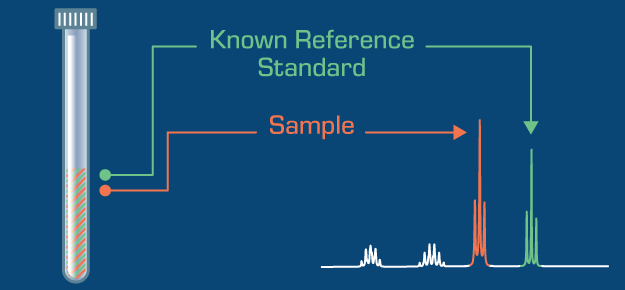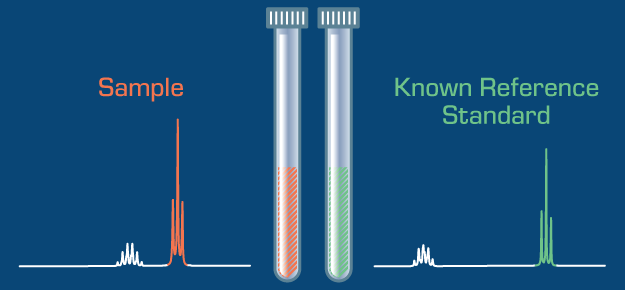May 24, 2024
by Sarah Srokosz, Marketing Communications Specialist, ACD/Labs
NMR Data Has More to Offer Than Single 2D Structural Analysis
Nuclear Magnetic Resonance (NMR) spectroscopy is well known for its ability to provide detailed qualitative structural information. However, its utility extends far beyond qualitative analysis of single structures. As a non-destructive method to probe both intermolecular and intramolecular properties, NMR stands apart from other analytical techniques. Furthermore, NMR data contains information useful in a diversity of applications, ranging from determining sample concentrations or purity to providing intricate details of complex mixtures and three-dimensional structures.
In this blog post, we explore a selection of these sophisticated capabilities of NMR data—showcasing how ACD/Labs’ portfolio of software for NMR data analysis enhances these processes through automated workflows and advanced analytical techniques.
Quantitative NMR (qNMR)
NMR data is rich with qualitative structural information, making it easy to overlook its utility as a quantitative technique. However, it is an attractive option for determining the relative concentration or purity of a sample, especially when traditional analytical methods like chromatography might be challenging. offers the tools necessary to calculate NMR purity and relative concentration from your spectra.
Calculating Absolute Concentration from NMR Data
Using a known reference standard, you can also determine the absolute concentration of a compound in your sample. NMR Workbook Suite supports two workflows for this:
Internal Standard qNMR
Internal standard qNMR is the most accurate method for calculating absolute concentration by NMR. In this workflow, the standard is added directly to the sample, and peaks are compared within the same spectrum. By inputting the quantity of reference material added to the sample, NMR Workbook Suite can calculate the concentration of your analyte.

External Standard qNMR
Unfortunately, there are cases where a suitable internal reference standard cannot be found or where logistical constraints make internal standard qNMR impossible. In these situations, external standard qNMR allows the spectrum of the sample and the spectrum of the reference to be measured separately. The integration of the sample and reference peak are then compared across the two spectra.
Unsurprisingly, this introduces several opportunities for error leading to lower accuracy. One source of this error is the variation in volume of the NMR tubes used. This allows for different amounts of the solution in the tube to be in the active coil of the probe and can thus result in over/under reporting of sample purity or concentration. NMR Workbook Suite offers a method to compensate for this by normalizing the solvent integral in your spectrum with respect to that of the calibration spectrum before quantitation of your analyte.

High Throughput NMR (HT-NMR)
The introduction of automated sample handling solutions like high throughput autosamplers, and high sensitivity probes has shifted the bottleneck in NMR laboratories from data acquisition to data processing and analysis. Automating routine structure verification can significantly ease this burden.
Automated structure verification (ASV) is not meant to replace NMR scientists, but to reduce their routine verification workload. Even without 100% accuracy, ASV systems offer substantial time savings. So long as the inaccuracies result in false negative, not false positive results, a system with accuracy as low as 50% still allows scientists to cut the time they spend verifying structures in half.
NMR Workbook Suite’s batch ASV is deployed across various organizations with over 70% accuracy. In the pharmaceutical industry, leading companies like Amgen, Sanofi, and Novartis have significantly cut down the time scientists spent processing and analyzing spectra of known structures.
NMR Mixture Analysis
Whether in crude reaction mixtures, natural product extracts, or biological matrices, analytes rarely exist in isolation without prior separation. While there are obvious advantages in terms of time and resources to skipping this separation step, analytical data including NMR spectra of these samples can be ambiguous and complex to analyze.
Analyzing the components of a mixture by NMR can be done using a DOSY NMR experiment or using intelligent software algorithms.
Analyzing Mixtures with DOSY NMR
Diffusion Ordered Spectroscopy (DOSY) uses field gradient pulses and specialized pulse sequences to differentiate NMR signals from a mixture of molecules by the differences in their molecular translational diffusion. Once the DOSY dataset is acquired, NMR Workbook Suite offers the capability to generate DOSY contour plots using monoexponential fitting. It then allows you to process the resulting pseudo 2D NMR and extract individual components as single component spectra for dereplication with several reporting and database options available.
Software-Assisted Mixture Analysis
The right software can efficiently analyze a broader selection of mixtures without specialized experiments—saving instrument time and scientist effort. NMR Workbook Suite includes automated workflows for both targeted and untargeted mixture analysis.
Targeted Profiling of Mixtures by NMR
In the Targeted Profiling workflow, you only need to prepare the reference spectra and specify the peaks to be used for quantification to identify and quantify compounds from complex mixtures. The algorithm separates the spectra of the individual components to compare the relative integrals. This allows it to handle overlapping peaks effectively.
Automated Targeted Profiling is also available for batch analysis, capable of quantifying 200 spectra in less than 10 minutes, with results provided in a Spectrus database or as a CSV file.
Untargeted Mixture Analysis by NMR
Mixture analysis becomes more complex when the components of the sample are unknown. However, by breaking the spectra into small integral regions known as “buckets”, individual components can be identified and quantified using NMR data.
NMR Workbook Suite’s intelligent bucketing algorithm helps identify single peaks. You can also use the deconvolution algorithm to resolve overlapping peaks, providing greater accuracy. These data can then be used as inputs for specialized statistical programs, where principal component analysis can be performed.
Conformational Analysis with NMR Data
Beyond 2D structures, NMR can also provide 3D structural information through various methods.
Nuclear Overhauser Effect Spectroscopy (NOESY) and Rotating-frame nuclear Overhauser Effect Spectroscopy (ROESY) experiments probe through-space Nuclear Overhauser Effect (NOE) interactions, revealing atoms close together (less than 5 Å) in space.
Residual Dipolar Couplings (RDCs) are another way of obtaining 3D structural information by NMR. In this workflow, spectra of the analyte are recorded in an isotropic medium, as well as an anisotropic medium. The RDCs are measured by comparing couplings between these spectra, offering insights into the 3D structure. RDC analyses and NOESY/ROESY are orthogonal methods, which complement each other well.
NMR Workbook Suite supports the processing and analysis of 1D and 2D NOESY/ROESY data as well as the measurement of RDCs. While with , you can fit couplings to the 3D structures of conformers, aiding in molecular configuration determination.
Extract the Full Value of Your NMR Data
NMR spectroscopy’s versatility as both a qualitative and quantitative tool makes it indispensable in modern analytical laboratories. NMR Workbook Suite software leverages this versatility, providing automated solutions for purity determination, mixture analysis, and 3D structure elucidation. By streamlining workflows and reducing manual intervention, NMR Workbook Suite empowers scientists to achieve more accurate results in less time, enhancing productivity and precision in research and industry applications. Whether you’re tackling routine structure verification or exploring the complexities of unknown mixtures, NMR Workbook Suite is the tool that helps you unlock the full potential of NMR spectroscopy data.


